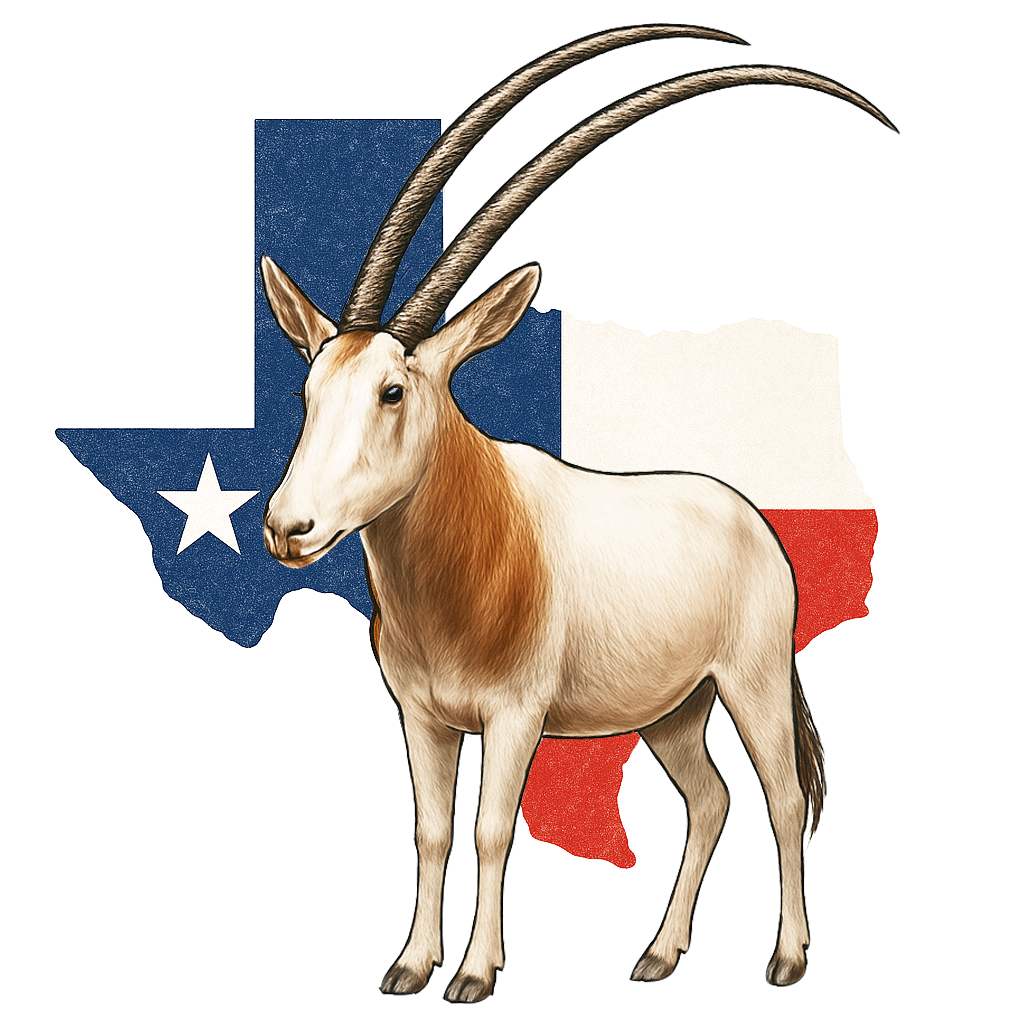
Real hunts at a beautiful private ranch in Texas.
Located north of Austin, just south of Killeen.
Scimitar-Horned Oryx: A Majestic Trophy and Sustainable Game Species
The scimitar-horned oryx is one of the most iconic exotic game species in North America — and for good reason. With its long, curved horns, striking white coat, and reddish-brown markings, the scimitar-horned oryx is not just visually stunning — it’s also an incredible hunt and a prized source of lean, delicious meat. Though native to the deserts of North Africa, this antelope has found a second life on Texas ranches, where it thrives in dry climates and open range conditions. For hunters seeking a unique, challenging, and conservation-minded experience, scimitar-horned oryx hunting is the total package.
Origins and Conservation: From Extinct to Abundant
Originally native to the semi-arid regions of North Africa, the scimitar-horned oryx (Oryx dammah) once roamed across vast swaths of the Sahara and Sahel. For centuries, it was a vital resource to desert-dwelling peoples, providing meat, hides, and horn materials. However, a combination of overhunting, habitat loss, and desertification led to a steep population decline throughout the 20th century. By the early 2000s, the species was declared extinct in the wild.
Fortunately, captive breeding programs — particularly those in Texas — played a key role in saving the species from total extinction. Private ranches across Texas and the southwestern U.S. now maintain healthy, free-ranging populations of scimitar-horned oryx, contributing to their global conservation. Some animals from Texas have even been reintroduced into protected areas in Chad, marking one of the most successful examples of conservation through sustainable use.
Appearance and Size: A Trophy Worth Pursuing
The scimitar-horned oryx is named for its sweeping, backward-curving horns that resemble a traditional Middle Eastern scimitar. These horns can grow over 40 inches in length and are present on both males and females, making every hunt a trophy opportunity. Their coats are a bright, almost pure white with a reddish-brown chest and facial markings, which provide some camouflage in their native desert habitat.
Mature bulls can weigh up to 450 pounds and stand over four feet at the shoulder. They are robust, hardy animals, capable of withstanding intense heat and long dry spells — traits that make them ideally suited for the Texas climate.
Behavior and Herd Dynamics
Scimitar-horned oryx are herd animals, typically moving in groups of 10 to 30 in the wild. On ranches, these herds often form stable, loosely structured groups dominated by a lead female. Males will often challenge one another for mating rights, but full-blown aggression is rare; displays of dominance usually involve posturing and low-level sparring with their horns.
Unlike some other antelope species, scimitar-horned oryx are diurnal and can be highly active during the heat of the day. They rely on sight and smell to detect predators and communicate with a variety of vocalizations, tail signals, and body language. When threatened, they may form a defensive circle with horns outward — a strategy that served them well against natural predators like lions.
Gestation, Breeding, and Lifespan
Scimitar-horned oryx breed year-round in suitable climates, though peaks are often observed in spring and early fall. The gestation period lasts about 8.5 to 9 months, typically resulting in a single calf. Calves can stand and walk within hours of birth and are usually weaned by the time they are three to four months old.
In captivity or on well-managed ranches, scimitar-horned oryx can live up to 20 years. Females usually reach sexual maturity at around two years of age, while males may take a bit longer to mature fully and earn a place in the breeding hierarchy.
Oryx Meat: A Lean, Nutritious Delicacy
Aside from its trophy value, the scimitar-horned oryx offers outstanding table fare. Oryx meat is incredibly lean — lower in fat and cholesterol than beef — and packed with protein, iron, and flavor. The texture is tender, especially when properly aged, and it works well in a wide range of recipes from steaks to sausages to slow-roasted dishes.
Because these animals live on natural forage and roam freely, the quality of the meat rivals that of grass-fed beef or elk. Many hunters are pleasantly surprised by the mild, almost sweet flavor, making scimitar-horned oryx a top choice for those who value both the hunt and the harvest.
Sustainability and Ethical Hunting
One of the biggest draws of hunting scimitar-horned oryx is its contribution to species conservation. Unlike threatened or endangered species in the wild, exotic game animals on private Texas ranches are part of self-sustaining populations that do not rely on public funding. Ethical hunting helps maintain herd health, balances sex ratios, and supports habitat management — all while offering a source of income that encourages landowners to keep wild land undeveloped.
In this way, hunting scimitar-horned oryx becomes more than a sport — it becomes a vital tool in the conservation of one of the planet’s most endangered antelope species.
Contact us today to book your scimitar-horned oryx hunt.














